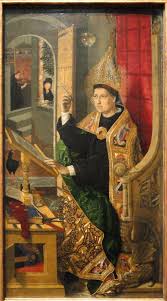Bartolomé Bermejo
Bartolomé Bermejo
Bartolomé Bermejo (1440 – 1501)
Bartolomé Bermejo (1440 – 1501) was a Spanish painter who adopted Flemish painting techniques and conventions.
Although it is unclear where Bermejo received his training, his complete mastery of the oil glaze technique suggests direct contact with 15th century Flemish painting, which he was able to adapt perfectly to the demands of Spanish altarpieces of the period: large-scale retables with many panels. Though his documented career spans over thirty years, he was peripatetic: he never settled in one place for more than a decade. Also, in a period and place where painting was a business, and work was generally negotiated by contract, there is both direct and indirect evidence that he was professionally unreliable, though apparently his outstanding talent made patrons willing to take the risk. At least three major altarpieces that he undertook, the high altar retables of Santo Domingo de Silos in Daroca and Santa Anna in Barcelona, and the triptych of the Virgin of Montserrat in Valencia, were left incomplete for others to finish.

Beyond his skill in oil glaze painting, Bermejo's distinctive style can be seen in his physical types, a lively sense of drama in his narrative scenes, and above all in his attention to landscape, particularly in the extensive sunrise and sunset settings in the Triptych of the Virgin of Montserrat and the Pietà. Bermejo's distinctive style had a considerable influence, particularly in Aragon, where it was widely disseminated in the prolific studio of Martín Bernat. No one at this time, however, could duplicate his landscapes.
There are three surviving works that incorporate the artist's name within the compositions, still unusual in Spanish painting of this period: Saint Michael with Kneeling Donor, Antonio Juan; the Triptych of the Virgin of Montserrat with Donor, Francesco della Chiesa; and the Pietà with Canon Desplà. The first two bear the artist's name on simulated parchment, and the last is found in an inscription on the frame. Indirect evidence also speaks of royal patronage, for an Epiphany now in the Royal Chapel of Granada was part of the personal collection of Isabella I of Castile.



